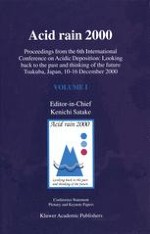2001 | OriginalPaper | Buchkapitel
Reappearance of Highly Acid-Sensitive Invertebrates after Liming of an Alpine Lake Ecosystem
verfasst von : Arne Fjellheim, Åsmund Tysse, Vilhelm Bjerknes
Erschienen in: Acid rain 2000
Verlag: Springer Netherlands
Enthalten in: Professional Book Archive
Aktivieren Sie unsere intelligente Suche, um passende Fachinhalte oder Patente zu finden.
Wählen Sie Textabschnitte aus um mit Künstlicher Intelligenz passenden Patente zu finden. powered by
Markieren Sie Textabschnitte, um KI-gestützt weitere passende Inhalte zu finden. powered by
The amphipod Gammarus lacustris was earlier a main food item of brown trout in Lake Svartavatnet at the Hardangervidda mountain plateau in South Norway. In the middle of the 1980’s, G. lacustris disappeared from the trout diet due to increased acidification. In order to preserve a unique genetic variant of brown trout living in the area, a liming programme was initiated in 1994. During the first years after liming, G. lacustris was absent both in fish stomachs and in lake littoral samples. In 1999, it reappeared in brown trout stomach samples together with two other strongly sensitive species, the tadpole shrimp Lepidurus arcticus and the freshwater gastropod Lymnaea peregra. Data from monitoring indicate that the water chemical conditions of L. Svartavatnet are still close to the critical limits of these animals. They have probably survived in small refuges of acceptable water quality, either in areas of inflowing groundwater or in the littoral, below the more acidic surface layer. The fact that these sensitive animals have not yet been found in benthic samples emphasise fish diet as an important tool in early registration of the presence/absence of invertebrates with low abundance or patchy distribution.
